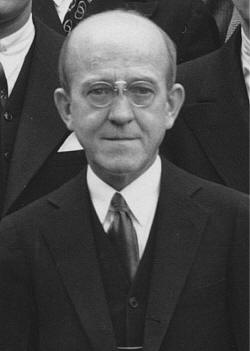

Partner Alphonse Dochez
Queer Places:
2370 Moran St, Halifax, NS B3K 4K2, Canada
Columbia University (Ivy League), 116th St and Broadway, New York, NY 10027
Mount Olivet Cemetery
Nashville, Davidson County, Tennessee, US
 Oswald Theodore Avery Jr. (October 21, 1877 – February 20, 1955) was
a Canadian-American physician and medical researcher. With
Alphonse Dochez, he
discovered the soluble substance that confers type-specificity upon
pneumococci. Their work demonstrated that the substance was of capsular origin
and present in both blood and urine of infected patients. The two, who often
collaborated, also revealed the importance of type-specific antibodies in
recovery from pneumococcal pneumonia. This discovery lead to the production of
the first effective pneumococcal pneumonia therapy. The therapy, using
type-specific anti-pneumococcal horse serum, was used until the development of
sulfonamides and
penicillin.[1] Avery and Dochez shared an apartment for decades.
Oswald Theodore Avery Jr. (October 21, 1877 – February 20, 1955) was
a Canadian-American physician and medical researcher. With
Alphonse Dochez, he
discovered the soluble substance that confers type-specificity upon
pneumococci. Their work demonstrated that the substance was of capsular origin
and present in both blood and urine of infected patients. The two, who often
collaborated, also revealed the importance of type-specific antibodies in
recovery from pneumococcal pneumonia. This discovery lead to the production of
the first effective pneumococcal pneumonia therapy. The therapy, using
type-specific anti-pneumococcal horse serum, was used until the development of
sulfonamides and
penicillin.[1] Avery and Dochez shared an apartment for decades.
The major part of Avery's career was spent at the Rockefeller University Hospital in New York City. Avery was one of the first molecular biologists and a pioneer in immunochemistry, but he is best known for the experiment (published in 1944 with his co-workers Colin MacLeod and Maclyn McCarty) that isolated DNA as the material of which genes and chromosomes are made.[4][5][6]
The Nobel laureate Arne Tiselius said that Avery was the most deserving scientist not to receive the Nobel Prize for his work,[7] though he was nominated for the award throughout the 1930s, 1940s, and 1950s.[8][9] The lunar crater Avery was named in his honor.
Avery was born in Halifax, Nova Scotia in 1877 to Francis Joseph Avery, a Baptist minister, and his wife Elizabeth Crowdy. The couple had immigrated from Britain in 1873. Oswald Avery was born and grew up in a small wooden row house on Moran Street in the North End of Halifax, now a designated heritage building.[10] When Avery was 10, his family moved to the Lower East Side of New York City. As a youth, Avery studied music at first and then switched to medicine at college, earning his medical degree and beginning a practice in 1904.[11]
For many years, genetic information was thought to be contained in cell protein. Continuing the research done by Frederick Griffith in 1927, Avery worked with MacLeod and McCarty on the mystery of inheritance. He had received emeritus status from the Rockefeller Institute in 1943, but continued working for five years, though by that time he was in his late sixties. Techniques were available to remove various organic compounds from bacteria, and if the remaining organic compounds were still able to cause R strain bacteria to transform then the substances removed could not be the carrier of genes. S-bacteria first had the large cellular structures removed. Then they were treated with protease enzymes, which removed the proteins from the cells before the remainder was placed with R strain bacteria. The R strain bacteria transformed, meaning that proteins did not carry the genes causing the disease. Then the remnants of the R strain bacteria were treated with a deoxyribonuclease enzyme which removed the DNA. After this treatment, the R strain bacteria no longer transformed. This indicated that DNA was the carrier of genes in cells.[12]
Alfred Hershey and Martha Chase furthered Avery's research in 1952 with the Hershey–Chase experiment. These experiments paved the way for Watson and Crick's discovery of the helical structure of DNA, and thus the birth of modern genetics and molecular biology. Of this event, Avery wrote in a letter to his youngest brother Roy, a bacteriologist at the Vanderbilt School of Medicine: "It's lots of fun to blow bubbles but it's wiser to prick them yourself before someone else tries to."[13]
Nobel laureate Joshua Lederberg stated that Avery and his laboratory provided "the historical platform of modern DNA research" and "betokened the molecular revolution in genetics and biomedical science generally".
The collected papers of Avery are stored at the Tennessee State Library and Archives and at the Rockefeller Archive. Many of his papers, poems, and hand written lab-notes are available at the National Library of Medicine in the Oswald T. Avery Collection, the first of their Profiles in Science series.[14]
My published books: